Capital Aigion (meeting place) Government Republican Confederacy Re-founded under the leadership of Aigion, with the aim to "expel the Macedonians" 280 BC Historical era Classical antiquity | Religion Ancient Greek religion Legislature Achaean assembly Founded 281 BC | |
 | ||
Languages Achaean Doric Koine, Koine Greek | ||
Europa universalis rome achaean league greece part 1
The Achaean League (Greek: Κοινὸν τῶν Ἀχαιῶν), also known as the Aegean League, was a Hellenistic-era confederation of Greek city states on the northern and central Peloponnese. The first league was formed in the 5th century BC. The second Achaean League existed between 280 BC and 146 BC. The league was named after the region of Achaea.
Contents
- Europa universalis rome achaean league greece part 1
- History
- Roman era
- Inscriptions
- Government
- Army
- Members
- From Achaea
- From Corinthia
- From Argolis
- From Arcadia
- From other regions
- List of Strategoi Generals
- References
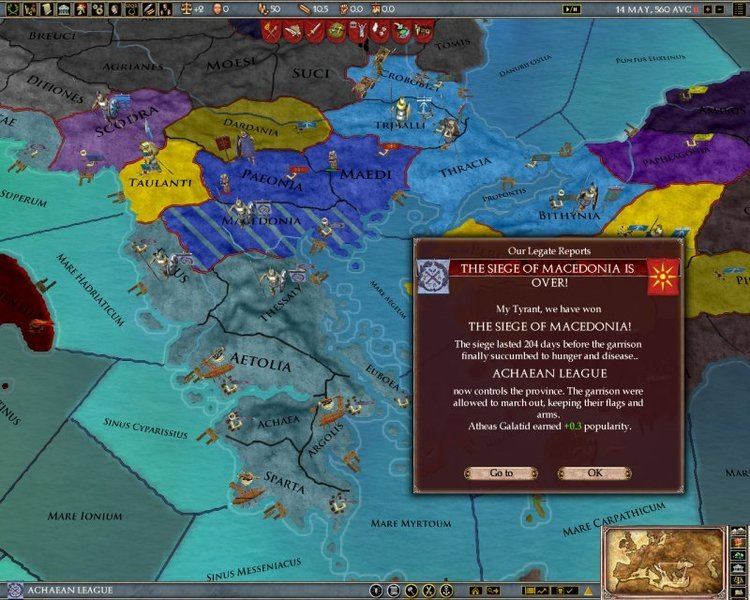
History
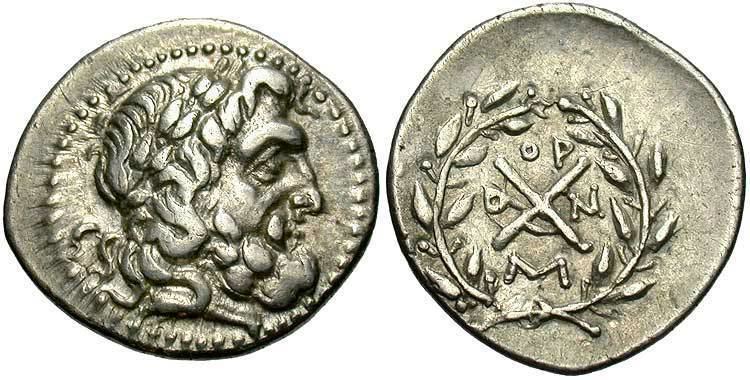
The regional Achaean League was reformed in 281/0 BC (on the basis of a looser alliance of the founding city-states extending back to the 5th century BC), and soon expanded beyond its Achaean heartland. It was first joined by the city of Sicyon in 251, which provided it with its first great leader, Aratus of Sicyon. The League soon grew to control much of the Peloponnese, considerably weakening the Macedonian hold on the area. It acquired Corinth in 243 BC, Megalopolis in 235 BC and Argos in 229 BC. The increased size of the league meant a bigger citizen army and more wealth, which was used to hire mercenaries. However the league soon ran into difficulties with the revived Sparta of Cleomenes III. Aratus was forced to call in the aid of the Macedonian King, Antigonus Doson, to defeat Cleomenes in Sellasia. Antigonus re-established Macedonian control over much of the region.
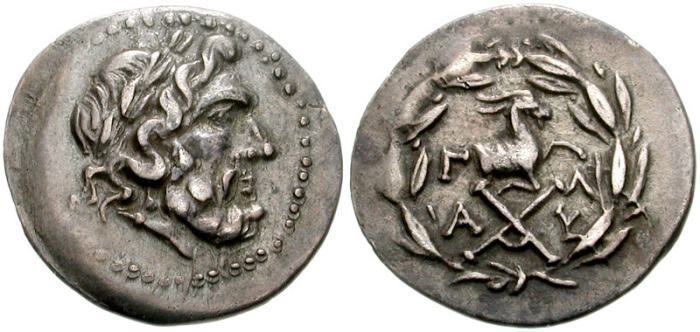
In 220 BC, the Achaean League entered into a war against the Aetolian League, which was called the "Social War". The young king Philip V of Macedon sided with the Achaeans and called for a Panhellenic conference in Corinth, where the Aetolian aggression was condemned.
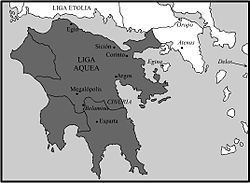
After Aratus's death, however, the League was able to reap much of the benefits of Macedon's defeat by Rome in 197 BC. Under the leadership of Philopoemen, the League was able to finally defeat a heavily weakened Sparta and take control of the entire Peloponnese.

The League's dominance was not to last long, however. During the Third Macedonian War (171–168 BC), the League flirted with the idea of an alliance with Perseus, and the Romans punished it by taking several hostages to ensure good behavior, including Polybius, the Hellenistic historian who wrote about the rise of the Roman Republic. In 146 BC, the league erupted into an open revolt against Roman domination, the Achaean War. The Romans under Lucius Mummius defeated the Achaeans at the Battle of Corinth, razed Corinth and dissolved the League. G.T. Griffith has written that Achaean War was a hopeless enterprise for the Achaeans, badly led and backed by no adequate reserves of money or men. Lucius Mummius received the agnomen Achaicus ("conqueror of Achaea") for his role.
Roman era

The original name Koinon of Achaeans (Achaean League) continues to exist in epigraphy, denoting either the previous Peloponnesian members (see koinon of Free Laconians) or the whole of Roman Achaea. In c. 120 BC Achaeans of cities in the Peloponnese dedicated an honorary inscription to Olympian Zeus, after a military expedition with Gnaeus Domitius against the Galatians in Gallia Transalpina. In Athens, AD 221-222 the koinon of Achaeans, when the strategos was Egnatius Brachyllus, decided to send an embassy to the emperor Caracalla
Inscriptions
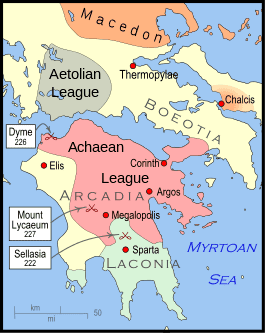
An inscription from ancient Orchomenus dating to 234–224 BC states that members of the Achaean Federation must invoke Zeus and Athena.
Government
The government of the league had a council of citizens, a smaller council of ten Demiourgoi, and a Strategos. Each city had one vote in the council of Demiourgoi.
Army
The Achaean army was an army of the traditional hoplite type. From the 270s onwards however, much like the rest of Greece, the emergence of the Celtic shield known as the thureos was incorporated into Greek warfare and a new type of troop was developed. Reforming their troops into thureophoroi, the Achaean army was now composed of light troops. The thureophoroi were a mixture of evolved peltasts and light hoplites, carrying the thureos shield, a thrusting spear and javelins. Plutarch tells of how they could be effective at a distance, but in close combat the narrow thureos shield disadvantaged them. He also describes how they would form a formation of sorts, but it would be ineffective, as it would not have inter-locked shields or a ‘leveled line of spears’. Aratus, one of the major Achaean strategoi and statesmen was known for his use of light forces for irregular operations, a type of warfare suited to the thureophoroi but not suited to operations in the open field.
The League in 217 decided to maintain a standing force of 8,000 mercenary foot and 500 mercenary cavalry, added to a picked citizen force of 3,000 infantry and 300 cavalry, of which 500 foot and 50 horse would come from Argos and the same amount from Megalopolis. Aratus also obtained 500 foot and 50 horse each from Taurion and the Messenians for defence of parts of the League open to attack via Laconia. The citizen infantry would have been armed as thureophoroi, apart from the citizen light troops who would have been archers and slingers etc. This picked citizen force may well have existed before these so-called reforms, at least on an official basis, as we know of a similar elite force of the same size as Sellasia in 222. However, it was the Achaean general Philopoemen in 208 who changed the Achaean fighting style and weaponry to the Macedonian fashion. This was due to the influence of Philip V of Macedon, who supported Philopoemen. Philip, at the time of Philopoemen's reforms, was in a full-scale war and could not support or finance the League. He realized that the League had to become militarily self-sufficient but also kept in the Macedonian sphere, lest the League join Macedon's rivals. Philip V probably supported Philopoemen for strategos for the year 208/07 and in doing so was able to get what he wanted. According to Plutarch, Philopoemen ‘persuaded them to adopt long pike and heavy shield instead of spear and buckler, to protect their bodies with helmets and breastplates and greaves, and to practice stationary and steadfast fighting instead of the nimble movements of light-armed troops’. These ‘reforms’ were not necessarily new to some of the constituent cities of the League, the city of Megalopolis had been given bronze shields and armed in the Macedonian fashion by Antigonus Doson for the Sellasia campaign many years before. Philopoemen then trained the new army how to fight with the new weapons and tactics and how to co-ordinate them with a new mercenary corps that was hired. He spent nearly 8 months in his term as strategos visiting, training and advising cities in this capacity. At the Battle of Mantinea in 207 BC the Achaean phalanx was positioned with intervals between the companies with lighter troops. This was obviously a major attempt by Philopoemen to increase the flexibility of his phalanx. He too may have picked this tactic up from his experience at the Battle of Sellasia, where the phalanx of Antigonus Doson was also divided up with light/medium troops in between them. As well as reforming and re-organizing the infantry, Philopoemen also did this with the citizen cavalry. The cavalry was recruited, much like in other Greek states, from the rich and noble classes. Philopoemen organized the cavalry in lochoi, which usually in ancient military treatises means ‘files’, most probably of 8 men, grouped into dilochiai, a formation of double-files of 16 and so forth. However, by the time of the Achaean war in the 140s BC, the League's army had decreased in strength and efficiency. The League was even reduced to freeing and arming 12,000 slaves. This was probably due to the 2nd century BC decline in population. This may well account for the increased hiring of mercenaries, especially Cretans and Thracians.
Members
The below are the original Peloponesian members, except the ancient regions of Sparta, Elis and Messenia. Later Hypana in Elis, Corone, Messene, Sparta and Pagae in Attica were joined by conquest. In 223 BC, Megara in Attica deserted the Achaean League and joined the Boeotian Confederacy.
Besides many city-states on the Mainland joining the Achaean Federation, certain Mediterranean island city-states also became part of the federation. For example, Kydonia on Crete joined at some time after 219 BC.
The city of Helike had been an important member of the first Achaean League, but sank into the sea following a disastrous earthquake in 373 BC. The town of Olenus, also one of the twelve members of the first Achaean League, had been abandoned before 280 BC, but was sometimes counted as though still extant.
The dates in brackets indicate the year of first adhesion. Some cities had periods of separation or foreign occupation and later joined again.
From Achaea
From Corinthia
From Argolis
From Arcadia
From the ancient political geography of Arcadia, not totally compatible with modern Arcadia
